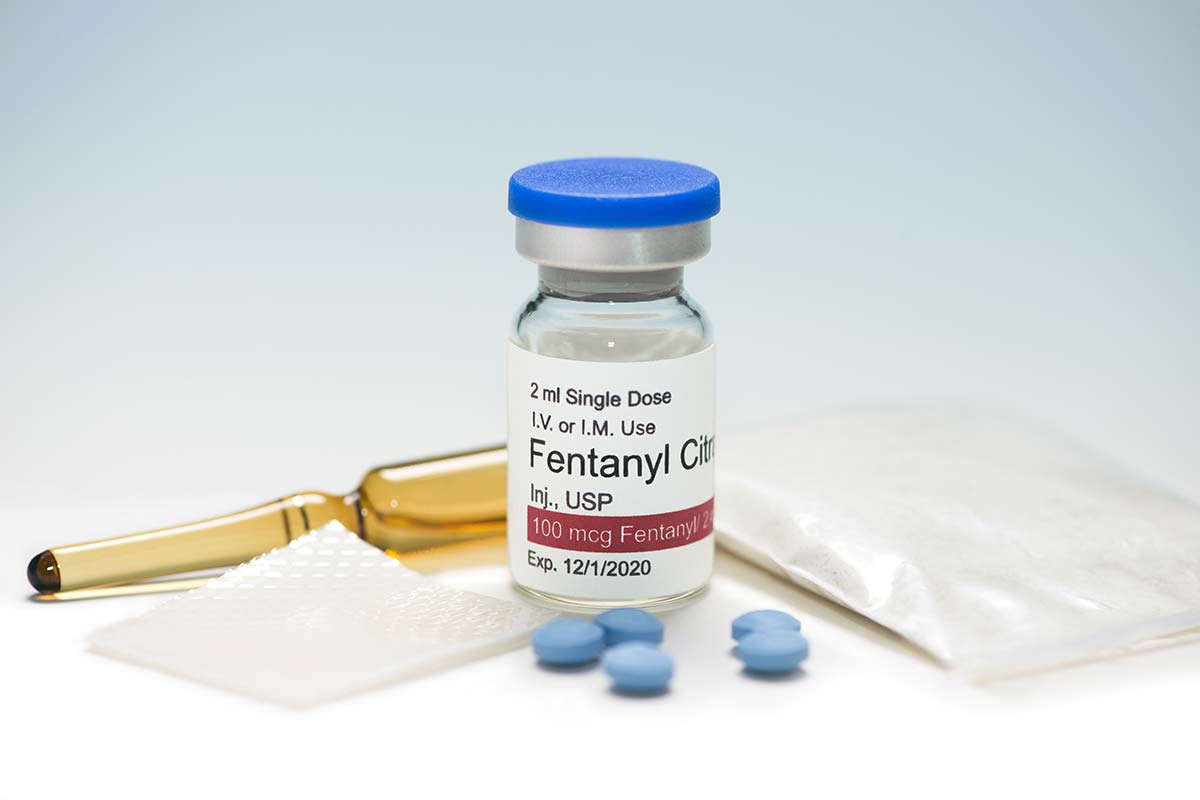Fentanyl abuse is increasing in the United States and throughout the world. While initially abused only in the medical community, fentanyl abuse is now mainstream and is one of the main driving forces behind the opioid epidemic. Fentanyl is a type of prescription opioid, which is an analgesic medication. Analgesics like fentanyl are used to treat severe and chronic pain. Fentanyl, a synthetic opioid 50 times more potent than heroin, is generally prescribed sparingly, often for invasive surgeries or in cases of excruciating back injuries. However, over the last few decades, prescriptions for opioids have dramatically increased. According to The Centers for Disease Control and Prevention, out of every 100 Americans there are approximately 58 opioid prescriptions. 17% of Americans currently have at least one opioid prescription. While there are plenty of people who take pain relievers as prescribed, the increased prevalence of fentanyl makes it easier to abuse, both for people holding legitimate prescriptions and for those obtaining it on the black market. As a result, this potent pain reliever is currently playing a major role in the United States’ opioid addiction crisis.
Due to the opioid crisis, drug overdose has surpassed automobile crashes as the number one leading cause of accidental death in the United States. In 2015, there were 20,101 deaths involving prescription opioids in the United States. This number is increasing rapidly. In 2018 alone, approximately 31,000 Americans died from overdosing on synthetic opioids.

The distinction between people who abuse fentanyl, synthetic opioids in general, and street drugs such as heroin is often fuzzy. Legitimate use of prescription opioids like fentanyl ultimately leads to physical dependency that can drive people to buy heroin, which is often easier to access. Additionally, people often unintentionally consume fentanyl while ostensibly using other substances. Dealers frequently lace poor quality heroin with fentanyl to make it more potent. It is also common to add it to other substances. Because fentanyl is so potent in such small quantities, it is extremely difficult to measure it out in correct amounts. As a result, fentanyl is indirectly implicated in many overdose deaths involving opioids of all kinds, and even overdose deaths involving stimulants, which, when mixed with fentanyl, become far more life-threatening.
While fentanyl is often used legally and healthily by people suffering from acute and chronic pain, even this population is vulnerable to fentanyl addiction. Medical professionals refer to fentanyl addiction as opioid use disorder (OUD). Individuals suffering from opioid use disorder find themselves using fentanyl compulsively, experience negative emotions or physical anguish when they do not have access to the substance, and find it impossible to control their use. The most obvious sign of an opioid use disorder is when a person wants to wean off or quit fentanyl entirely but find that they are unable to carry out their plan. This inability to act on the intention to quit can induce feelings of helplessness and depression and is a primary source for the profound demoralization that accompanies addiction. Unfortunately, many people with legal prescriptions for fentanyl believe that they are immune to addiction because they believe the legitimacy of their prescription makes it a safe drug.
Fentanyl addiction, whether arising from black market use or a legal prescription, can utterly destroy a person’s life. Relationships with friends and family can be damaged. Many find it difficult if not impossible to obtain or maintain a job. It is common for those with opioid use disorder to suffer legal and financial difficulties as a result of their drug-seeking behavior. Beyond all this, fentanyl puts individuals at risk of suffering from major physical and mental health problems. Many people suffer from fatal drug overdoses before they have even begun to explore treatment options.
Opioids like fentanyl affect receptors in the brain responsible for motivation and decision making, so quitting fentanyl alone is rarely possible. Anyone addicted to fentanyl requires outside help. Addiction treatment for fentanyl addiction is usually a multi-step process during which a variety of treatment options and modalities are combined to meet the unique and changing needs of individuals as they make a recovery. Treatment centers may make use of support groups, medications that alleviate withdrawal symptoms, cognitive-behavioral therapy, and even family therapy. The idea behind substance abuse treatment is not only to help people avoid relapse, but to rebuild a healthier and happier life in sobriety.
The first step anyone trying to quit fentanyl should take is enrolling in an opioid detox program. During this initial period, individuals begin weaning off or withdrawing entirely from fentanyl and other opioids. Because fentanyl is such a potent opioid, people withdrawing from it are likely to experience a variety of painful physical and psychological withdrawal symptoms. Medical professionals at a detox program can assist patients by prescribing methadone or buprenorphine, medications that have been proven to alleviate cravings and some of the more severe withdrawal effects. Even for users who quit “cold turkey,” having access to the medical supervision that detox centers provide is very important. Withdrawing without supervision can have disastrous health consequences and can lead to relapses that are unpredictably dangerous after a user has decreased their tolerance during a period of abstinence. Moreover, people benefit from the moral support, counseling, and the social support system that detox centers provide. A medical detox program, which can last from a few days to a few weeks, allows people to make a start on their journey to sobriety with access to all the resources they need.
Fentanyl addiction, like all substance use disorders, cannot be “cured,” no matter how long one remains physically abstinent. Substance use disorder is a type of chronic illness that can, however, be managed through consistent treatment. The nature of this treatment will inevitably change as individuals develop a stronger foundation in sobriety. After finishing a medical detox program, case workers generally advise enrolling in a residential treatment center or outpatient addiction program. There, individuals can begin doing the more important work that follows withdrawal: reflecting on the underlying issues behind their addictions, learning coping strategies, improving mental health, and developing new skills. Even after leaving formal treatment programs, most people continue to stay involved in support groups or 12-step programs where they can continue to work toward building a new life in sobriety.
People who suffer from fentanyl addiction are said by psychiatrists to suffer from opioid use disorder, an umbrella term that covers addiction to heroin as well any other synthetic opioid. Psychiatrists use a book called the Diagnostic and Statistical Manual of Mental Disorders, or DSM-5, to identify patients with opioid use disorders. According to the National Institute on Drug Abuse, in the United States approximately 8-12% of people who are prescribed opiates for chronic pain develop an opioid use disorder. Fentanyl, which is among the most potent opiates, has a much higher rate. The DSM-5, developed by the American Psychiatric Associated, lists eleven symptoms that someone who abuses fentanyl is likely to experience. If someone suffers from two or more of these symptoms, they meet conditions to be clinically diagnosed:
People addicted to fentanyl or any other synthetic opioid are at increased risk of suffering from severe physical and mental health problems. Fentanyl abuse can also be life-threatening in the event of a fentanyl overdose. A fatal overdose becomes even more likely when fentanyl is used in conjunction with other street drugs. Mixing fentanyl is particularly dangerous, especially with stimulants, which tax the heart and respiratory system while synthetic opioids simultaneously slow down body functions. In the event of an overdose, it is crucial to call 911 after providing the individual with naloxone, a drug that can reverse the effects of a potentially fatal overdose.

Opioid addiction also puts every component of an individual’s life at risk. In an effort to avoid experiencing excruciatingly painful withdrawal symptoms, most users stop at nothing to obtain the drug and prioritize fentanyl use above all else. Casualties can include career, family, and even personal freedom. Many individuals with substance use disorders have major relationship problems, which can lead to divorce or loss of child custody.
It can be difficult to hold on to a job or manage money, leading to financial ruin and even homelessness. Criminal activities associated with drug-seeking can result in criminal consequences and sometimes incarceration. As all of this is happening, many individuals begin to experience mental health problems, including depression, anxiety, and even sometimes psychosis.
People with drug addictions are far more likely to develop mental illnesses, which can further increase their dependency on drugs that provide short term relief. It does not take long for someone addicted to fentanyl to experience some of the life-threatening side effects and risks of an opioid use disorder.
Fentanyl Patch
The fentanyl patch is the most common type of prescription given by medical professionals. This slow-release patch can steadily dose users for several days. For users who have no tolerance for opioids, contact with the sticky potent side of the patch can lead to overdose. An additional danger is that even when an overdose is reversed using naloxone, users might overdose again sometime shortly afterwards due to the timed-release nature of the patch.
Injecting Fentanyl
People either inject fentanyl powder or the gel from the backside of the fentanyl patch. Aside from overdose, this method can lead to a number of health problems, including collapsed veins and an increase in the likelihood of contracting a blood borne illness such as HIV or hepatitis B and C.
Snorting Fentanyl
Fentanyl can also be snorted. Doing so is likely to damage nasal cavities over the long term, in addition to all the other risks associated with this high potency synthetic opioid.
Smoking Fentanyl
Smoking fentanyl, while not as intense as injecting it, is the fastest way for effects to reach the brain. Abusing fentanyl in this way further increases the likelihood of addiction as well as lung disease.
Chewing Fentanyl
Some people choose to chew the fentanyl patch. Doing so is very likely to lead to a fentanyl overdose, as it causes all of the fentanyl in the patch (which is meant to last for 2-3 days) to be released all at once.
Drinking Fentanyl
A less common method is boiling the fentanyl patch and brewing it into a kind of tea. While drinking fentanyl tea slows down the effects because it has to be processed by the stomach first, it is still extremely dangerous to the high potency of the contents of the patch.

As the brain and body become accustomed to fentanyl, the brain’s opioid receptors actually multiply and users also adapt to the enormous amounts of dopamine flooding their brains. As a consequence, individuals must take higher doses of fentanyl or take it more frequently to get high. This phenomenon is called tolerance. Even at relatively low doses, fentanyl’s potency also implies severe withdrawal symptoms and side effects. At the higher doses that people with physical dependence take, stopping or cutting down can produce excruciating illness. When people begin uncontrollably taking increasingly higher doses of fentanyl to stave off withdrawal or to get high, they can be said to suffer from opioid use disorder.

People who abuse fentanyl are far more likely to develop mental illness than other populations. The reverse is also true: individuals with mental health conditions are likely to turn to prescription opioids to alleviate their distress over the short term. Individuals suffering from substance use disorders alongside other mental health disorders are referred to as “dual diagnosis” or “comorbid.” The National Survey on Drug Use and Health estimates that there are 9.2 million adults qualifying as dual diagnosis in the United States. These patients require a higher degree of care, since relapse is likely if both conditions are not treated simultaneously.
People who abuse fentanyl usually learn from experience that is difficult if not impossible to stop using without outside help. People who attempt to quit on their own, a practice known as quitting “cold turkey” usually find that they return to substance abuse within a few hours, days, weeks, or months. Experiencing the anguish of opioid withdrawal only to return to opioid abuse shortly after can be especially demoralizing. It is important to understand that without first addressing the causes and conditions that lead to addiction, remaining physically abstinent for a period of time is unlikely to result in long term sobriety.
Part of the reason it is so difficult to quit fentanyl without help is that fentanyl abuse actually leads to lasting changes in brain chemistry. Opioids like fentanyl actually alter the reward centers of the brain that control motivation and decision making, meaning that no matter how much one desires to quit in the abstract sense, on the neurological level the brain will continue to demand more fentanyl. Even after quitting for a long period of time and eliminating physical dependence on the drug, without outside help a return to substance abuse is likely.
Most people rarely even get that far, however. People suffering from a physical dependence on fentanyl will experience an array of physical symptoms and side effects during opioid withdrawal that vastly exceed heroin withdrawal in intensity. According to the National Institute on Drug Abuse, symptoms of withdrawal include anxiety, insomnia, cold flashes, muscle and bone aches, heavy sweating, irregular heart rhythms, high blood pressure, and gastrointestinal issues such as vomiting and diarrhea. These symptoms are accompanied by severe cravings that can drive people hoping to relieve their suffering to relapse. Withdrawing at a treatment center under careful medical supervision can help people treat the majority of these symptoms. It is also much safer, since rapid changes in blood pressure and gastrointestinal issues can actually be fatal in some cases. Attending a licensed medical detox program isn’t just an easy way out — it’s the safest and most effective approach.
Create Recovery Center’s fentanyl addiction treatment program is designed by counselors and medical professionals with extensive experience in addiction recovery. Offering evidence-based treatment modalities in a safe and nonjudgmental environment, Create Recovery Center takes a holistic approach to make sure that the unique needs of each individual are met.
It is Create Recovery Center’s philosophy that sobriety involves more than just physical abstinence from fentanyl. Our goal is to help individuals rebuild their lives by learning and developing skills that will aid them in the future. We work individually with each patient to make sure they are fully prepared not only to avoid relapse over the long term, but to live happy and fulfilling lives in sobriety.

Services we offer include:
Whether you are just beginning an outpatient program or ready for an aftercare plan, Create Recovery Center is here for you if you’re ready to make a change. Fentanyl addiction can feel hopeless, but individuals who have progressed through our program have a different story to tell. Long term sobriety is yours if you want it. Contact Create Recovery today.